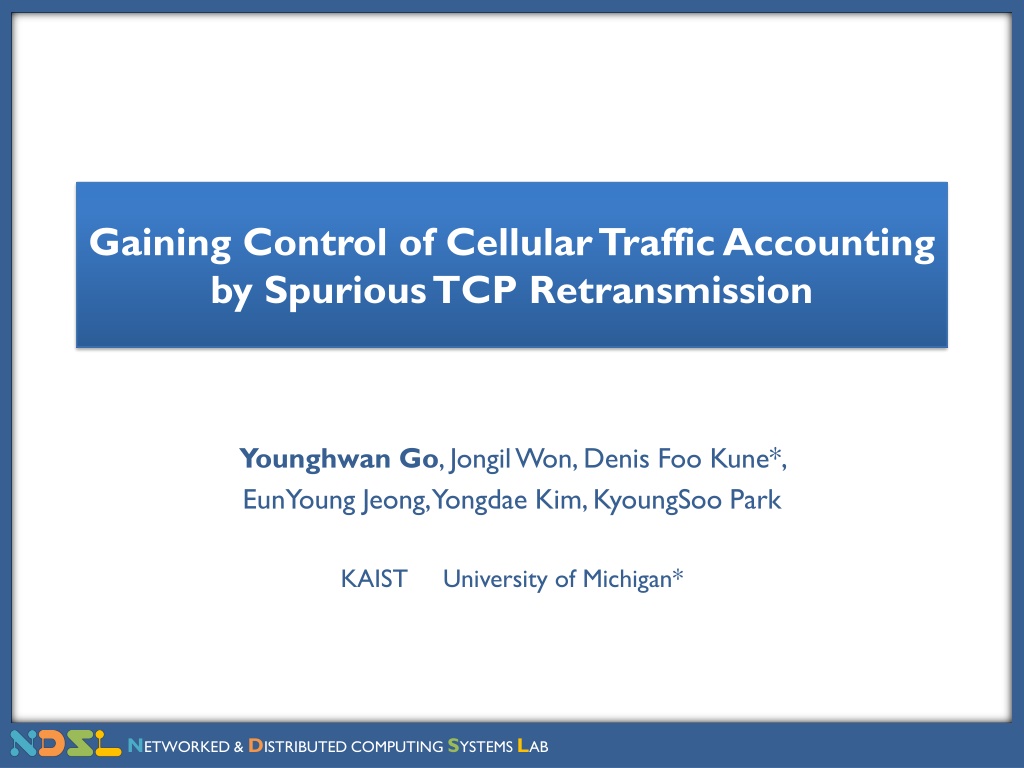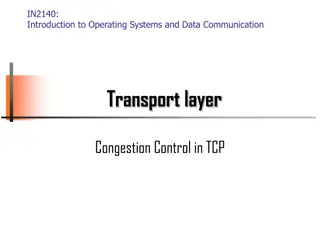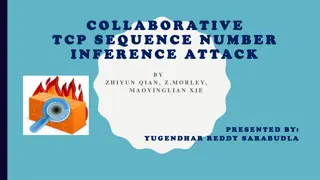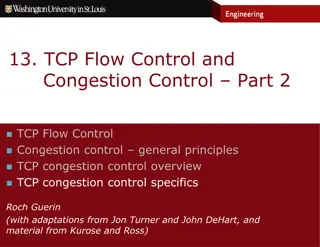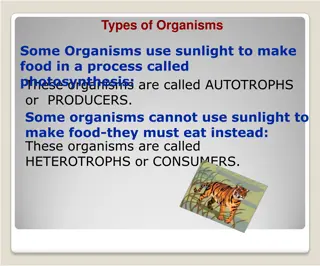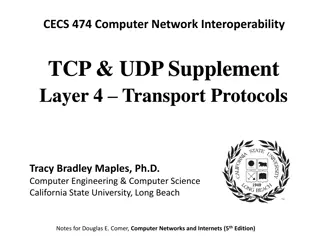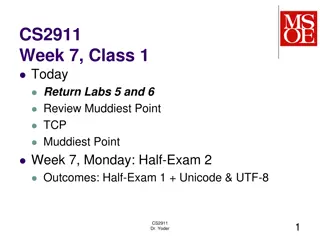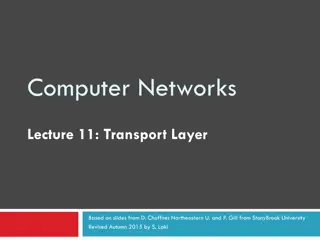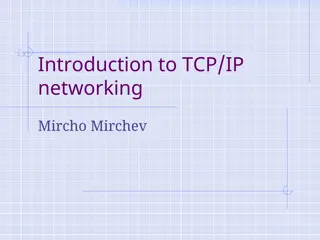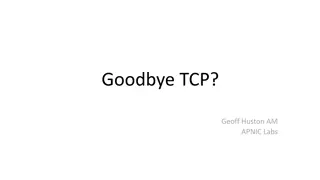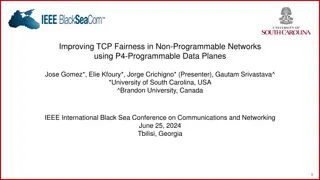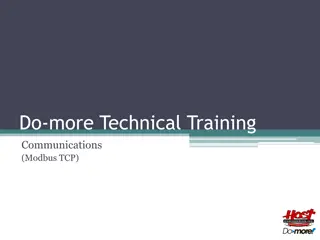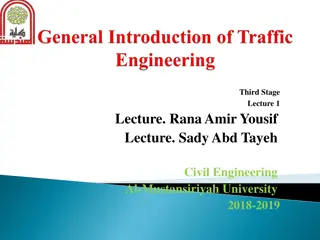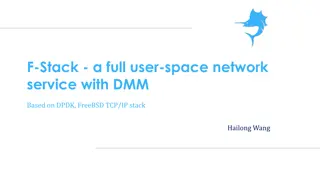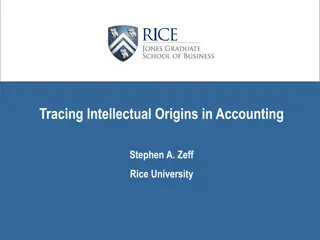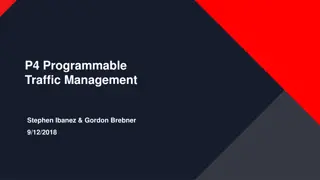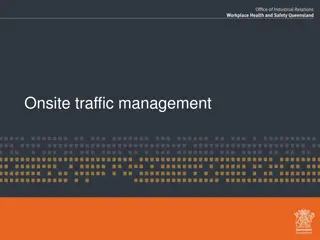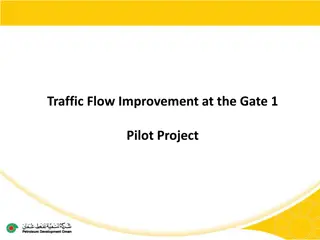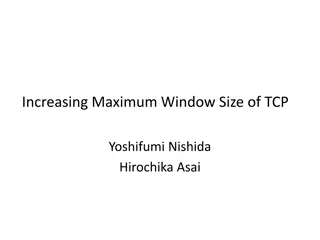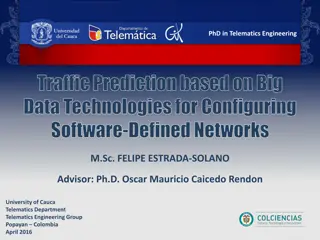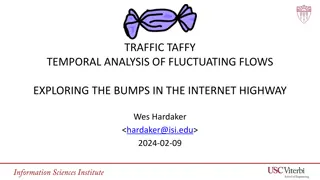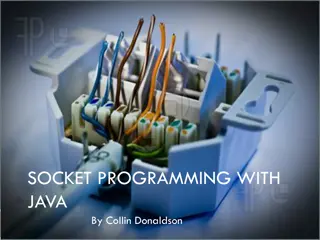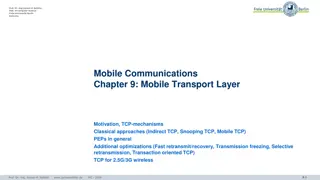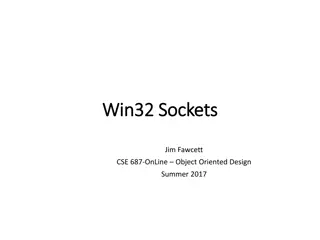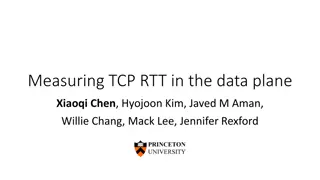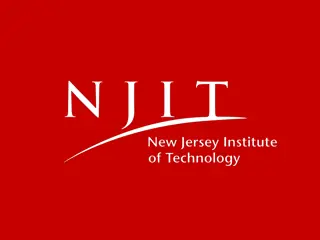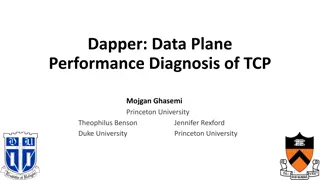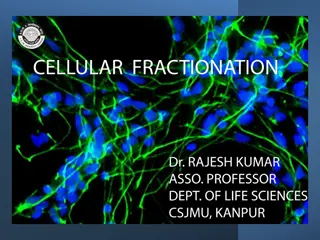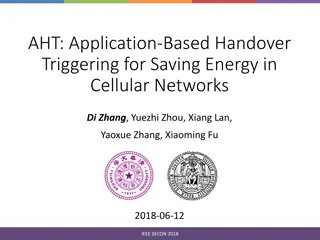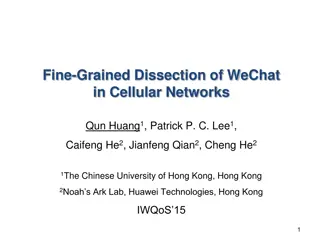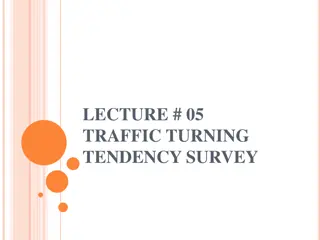Understanding Cellular Traffic Accounting and TCP Retransmissions
Delve into the complexities of cellular traffic accounting, focusing on the impact of TCP retransmissions on network data billing. Explore the challenges faced by cellular providers in accurately charging subscribers for data usage amidst increasing traffic volumes. Consider the implications of TCP retransmissions on billing accuracy and network performance.
Download Presentation

Please find below an Image/Link to download the presentation.
The content on the website is provided AS IS for your information and personal use only. It may not be sold, licensed, or shared on other websites without obtaining consent from the author. Download presentation by click this link. If you encounter any issues during the download, it is possible that the publisher has removed the file from their server.
E N D
Presentation Transcript
Gaining Control of Cellular Traffic Accounting by Spurious TCP Retransmission Younghwan Go, JongilWon, Denis Foo Kune*, EunYoung Jeong, Yongdae Kim, KyoungSoo Park KAIST University of Michigan* NETWORKED & DISTRIBUTED COMPUTING SYSTEMS LAB
Mobile Devices as Post-PCs Smartphones & tablet PCs for daily network communications NETWORKED & DISTRIBUTED COMPUTING SYSTEMS LAB 2
Mobile Devices as Post-PCs Smartphones & tablet PCs for daily network communications Massive growth in cellular data traffic (Cisco VNI Mobile, 2014) 1.7x increase in 1 year! NETWORKED & DISTRIBUTED COMPUTING SYSTEMS LAB 3
Cellular Traffic Accounting Increase in cellular traffic bill Average: $71 per month (2011) J.D. Power & Associates US raw mobile data price most expensive in the world ITU Oct, 13 500MB $85 (US), $24.1 (China), $8.8 (UK), $4.7 (Austria) Verizon 0.5GB 1GB 2GB 4GB 6GB 8GB Mobile Share with Unlimited Talk &Text $40 $50 $60 $70 $80 $90 Overage fee $15 per 1GB = $43,377.92! Cellular network subscribers want accurate accounting! NETWORKED & DISTRIBUTED COMPUTING SYSTEMS LAB 4
3G/4G Accounting System Architecture Charging Data Record (CDR) Billing information (e.g., user identity, session elements, etc.) Record traffic volume in IP packet level $ Question: BS NodeB Most of traffic is done via TCP (95%) [Woo 13] Then, should we account for TCP retransmissions? 3G UMTS GGSN G-CDR SGSN S-CDR RNC NodeB CGF Target Server Internet UE eNodeB P-GW S-GW 4G LTE MME RAN CN NETWORKED & DISTRIBUTED COMPUTING SYSTEMS LAB 5
Cellular Providers Dilemma: Charging TCP Retransmissions Subscriber s stream of consciousness Pay for application data only! What s TCP retransmission? Network condition is not my problem Charge volume = content size NETWORKED & DISTRIBUTED COMPUTING SYSTEMS LAB 6
Cellular Providers Dilemma: Charging TCP Retransmissions Cellular ISP s stream of consciousness Need to update the system Charge for all packets! Question: How serious is TCP retransmission in the real-world? Retransmission = another IP packet Result: Average users do not experience retransmission (0.4 1.7%) But some users may suffer from high cellular bills! Daejeon (South Korea): 85%, Princeton (New Jersey): 80% NETWORKED & DISTRIBUTED COMPUTING SYSTEMS LAB 7
Contributions Identify current TCP retransmission accounting policies of 12 cellular ISPs in the world Some ISPs account for retransmissions (blind), some do not (selective) Implement and show TCP retransmission attacks in practice Blind Usage-inflation attack Overcharge a user by 1 GB in just 9 minutes without user s detection! Selective Free-riding attack Use the cellular network for free without ISP s detection! Design an accounting system that prevents free-riding attack Accurately identify all attack packets Works for 10 Gbps links even with a commodity desktop machine NETWORKED & DISTRIBUTED COMPUTING SYSTEMS LAB 8
TCP Retransmission Accounting Policy Tested 12 ISPs in 6 countries ISPs (Country) Policy AT&T, Verizon, Sprint, T-Mobile (U.S.) Blind Telefonica (Spain) Vulnerable to usage-inflation attack! Blind OS (Germany) Blind T-Mobile (England) Blind China Unicom, CMCC (China) Vulnerable to free-riding attack! Blind SKT, KT, LGU+ (South Korea) Selective NETWORKED & DISTRIBUTED COMPUTING SYSTEMS LAB 9
Usage-inflation Attack Intentionally retransmit packets even without packet losses ISPs with blind accounting policy charge for all packets User clicks on the URL Strength: No need to compromise the client User does not notice an attack Inflate more than 1GB in just 9 minutes! Retransmit in background NETWORKED & DISTRIBUTED COMPUTING SYSTEMS LAB 10
Retransmit after RST Ignore client s RST to prevent TCP teardown Utilize full bandwidth to overcharge the usage Packet 1 $ $ $ Cellular Networks Packet 2 Wired Internet Packet 3 Request RST Packet 1 Packet 2 Packet 3 Packet 3 Packet 3 Billing System $ Packet 3 $ Packet 3 Malicious Server Victim Client Some ISPs allow attacks even after 4 hours! NETWORKED & DISTRIBUTED COMPUTING SYSTEMS LAB 11
Retransmit during Normal Transfer ISP may block data packet retransmissions after RST Embed retransmission packets in stream of normal packets Guarantee minimum goodput for interactive content NETWORKED & DISTRIBUTED COMPUTING SYSTEMS LAB 12
Free-riding Attack Tunnel payload in a packet masquerading as a retransmission ISPs with selective accounting policy inspects TCP header only Wired Internet Cellular Networks $ Packet 1 Fake TCP Hdr For a detailed implementation method, please read our paper Request Packet 1 Packet 2 Packet 2 Packet 3 Packet 3 Packet 1 Packet 2 Packet 3 Fake TCP Hdr Fake TCP Hdr Packet 1 Packet 2 Packet 3 Fake TCP Hdr Fake TCP Hdr Fake TCP Hdr TCP Tunneling Proxy Billing System Malicious UE Destination Server NETWORKED & DISTRIBUTED COMPUTING SYSTEMS LAB 13
Free-riding Attack in Practice Attack successful in all 3 South Korean ISPs Demo video @ http://abacus.kaist.edu/free_riding.html Packet encryption evade tunnel header detection Packet compression increase data transfer speed NETWORKED & DISTRIBUTED COMPUTING SYSTEMS LAB 14
Optimizations Practical even for normal web browsing NETWORKED & DISTRIBUTED COMPUTING SYSTEMS LAB 15
Defending against Retransmission Attacks Difficult to fundamentally defend against usage-inflation attack Detect attack by a retransmission rate threshold 85% retransmission ratio for legitimate flows lead to false positives Monitor TCP sender behavior Hard to know from a middlebox [Floyd 99, Savage 99, Kuzmanovic 07] Relay every TCP connection via Performance Enhancing Proxy (PEP) Expensive, proxy becomes a new target of attack but defend against free-riding attack! ISPs should not charge for retransmissions Reasonable to defend against free-riding attack Attacker can simulate behavior of poorly-provisioned environment Accurately identify retransmission tunneled packets via DPI NETWORKED & DISTRIBUTED COMPUTING SYSTEMS LAB 16
How much should I charge? Abacus: Cellular Data Accounting System NETWORKED & DISTRIBUTED COMPUTING SYSTEMS LAB 17
Abacus: Deterministic DPI Byte-by-byte comparison of original vs. retransmitted packets Buffer size: 2 x Receive Window Size Accounting process Head seq: 0 Window: 2KB Next expected seq: 2048 Flow 0 W W ACKed Buffer for new data Compare for payload length! Strength: No false-positives! Retransmitted Packet! (Seq = 1024) Weakness: Require large memory! Packet (Src: 102.58.35.5 / Dst: 142.98.7.90) NETWORKED & DISTRIBUTED COMPUTING SYSTEMS LAB 18
Abacus: Probabilistic DPI Store payload by sampling and compare for the sampled data E.g., store 5 bytes out of 1,024-byte reduce memory by ~200x Prevent attacker from guessing the sampled byte locations Calculate byte location via per-flow key = ??????????_???{?????} Base Seq Num: 1024 A h p 1 f r Flow Key o b s s a H t \ p m t b i f Offset = SHA1 {Flow Key | BSN} Retransmitted Packet! (Seq = 1024) NETWORKED & DISTRIBUTED COMPUTING SYSTEMS LAB 19
Evaluation Environment setup Traffic generator (custom HTTP server & client) Dual Intel Xeon E5-2690 CPU (2.90 GHz, 2 octacores) 64GB RAM Intel 10G NIC with 82599 chipsets d-DPI Abacus Same as traffic generator p-DPI Abacus Intel i7-3770 CPU (3.40 GHz, quadcore) 16GB RAM Intel 10G NIC with 82599 chipsets All machines are connected to 10 GbpsArista 7124 switch Abacus monitors all packets via port mirroring NETWORKED & DISTRIBUTED COMPUTING SYSTEMS LAB 20
Microbenchmark d-DPI requires large memory for buffering 53.6GB @ 320K flows Begins to drop packets 320K flows p-DPI requires small memory & CPU 391MB @ 320K flows CPU usage stays under 100% even @ 320K flows NETWORKED & DISTRIBUTED COMPUTING SYSTEMS LAB 21
Real Traffic Simulation Replay 3G cellular traffic logs Measured in a commercial cellular ISP in South Korea [Woo 13] 11PM 12AM on July 7th, 2012 61 million flows 2.79 TB in volume Inject 100 free-riding attacks during replay Result: d-DPI & p-DPI accurately detect and report all of the attacks! NETWORKED & DISTRIBUTED COMPUTING SYSTEMS LAB 22
Conclusion Massive growth in cellular data usage Importance of accurate accounting of cellular traffic Cellular ISP dilemma Should we account for TCP retransmissions packets or not? Accounting policies differ between countries Vulnerabilities in current accounting system Usage-inflation attack Free-riding attack Abacus Reliably detect free-riding attack Manage 100Ks of concurrent flows with a small memory and CPU usage NETWORKED & DISTRIBUTED COMPUTING SYSTEMS LAB 23 HotMobile 13, Jekyll Island, GA, USA
Thank You! Any Questions? http://abacus.kaist.edu yhwan@ndsl.kaist.edu NETWORKED & DISTRIBUTED COMPUTING SYSTEMS LAB 24
Retransmission Rate Measurement Measurement environment 11 volunteers (graduate students in KAIST) 38 days (March 22nd April 29th, 2013) 151,469 flows (3.62GB) Packet analyzer Process captured TCP flows Calculate retransmission rate Overall retransmission rate = 0.4 1.7% Average users do not experience retransmission! But NETWORKED & DISTRIBUTED COMPUTING SYSTEMS LAB 25
Some flows experience high retransmission rates CDF of flows with at least one retransmitted packet Worst 10% Daejeon: 40-85% / Princeton: 49-80% Up to 93% retransmission in 3G cellular backhaul link [HotMobile 13] Finding: 85% 82% Charging TCP retransmissions may cause some legitimate users to suffer from high cellular bills! NETWORKED & DISTRIBUTED COMPUTING SYSTEMS LAB 26
Related Works Peng et. al. [MobiCom 12, CCS 12] Toll-free data access attack Bypass cellular accounting via DNS port, which used to be free-of-service U.S. ISPs now account for all packets going through DNS port South Korean ISPs verify DNS packets Stealth-spam attack Inject large volume of spam data via UDP after the connection is closed Attack limited as most of traffic is TCP (95%) Tu et. al. [MobiSys 13] Inject large volume of spam data via UDP while the user is roaming Packet drops during handoffs (e.g., 2G Attack not so severe in real life since TCP is most dominant 3G, 3G LTE) NETWORKED & DISTRIBUTED COMPUTING SYSTEMS LAB 27
Monbot Highly-scalable flow monitoring system [Woo 13] PacketShader I/O (PSIO) High-speed packet I/O Symmetric Receive-Side Scaling (S-RSS) Map packets in same TCP connection to the same CPU core NETWORKED & DISTRIBUTED COMPUTING SYSTEMS LAB 28
Probabilistic DPI Store payload by sampling and compare for the sampled data E.g., store 5 bytes out of 1,000-byte reduce memory by 200x 4-byte base sequence number Entry Randomly sampled byte between [bsn, bsn + 1023] NETWORKED & DISTRIBUTED COMPUTING SYSTEMS LAB 29
p-DPI Byte Sampling Prevent attacker from guessing the sampled byte locations Random offset: K = SHA1{Flow Key | BSN} Flow Key = ??????????_???{?????} Offset calculation per 1KB buffer 10 bits to represent each offset N = 5 Bernstein hash function to produce 64-bit output Base Seq Num: 0 h i f r s Flow Key A p 1 f o b s a H t \ p m t b K = SHA1 {Flow Key | BSN} Retransmitted Packet! (Seq = 1024) NETWORKED & DISTRIBUTED COMPUTING SYSTEMS LAB 30
Choosing n Choice of n-byte sampling Memory space efficiency vs. attack detection accuracy For 1000-byte size packet, attack detection probability: NETWORKED & DISTRIBUTED COMPUTING SYSTEMS LAB 31
